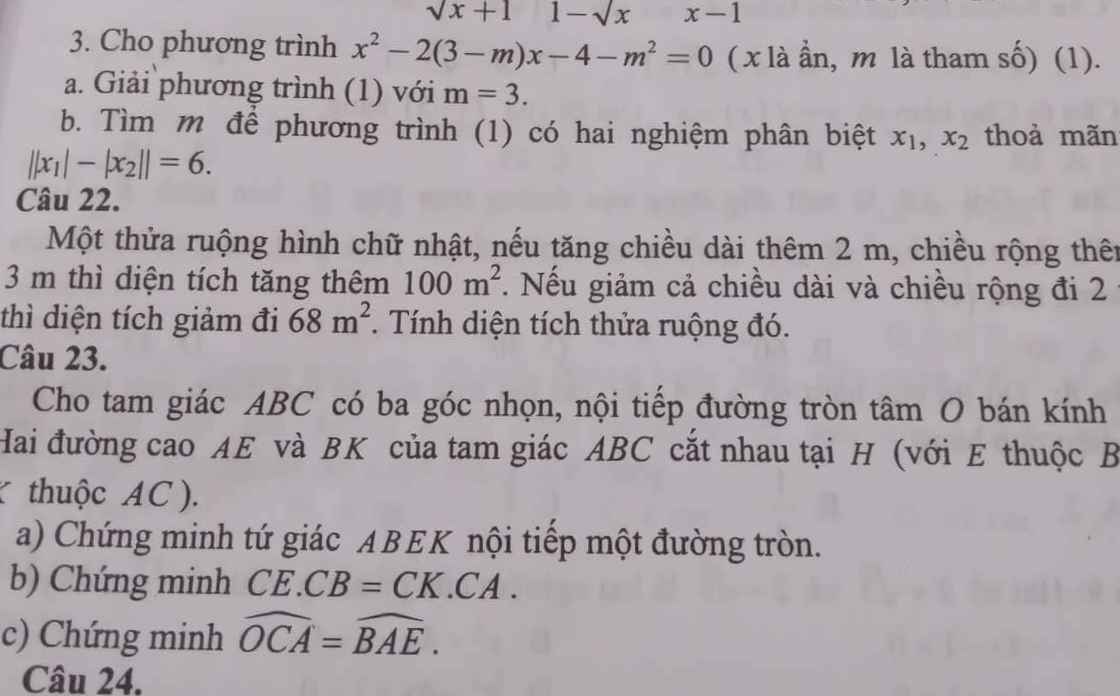Hãy nhập câu hỏi của bạn vào đây, nếu là tài khoản VIP, bạn sẽ được ưu tiên trả lời.

1.
\(a+b+c=0\) nên pt luôn có 2 nghiệm
\(\left\{{}\begin{matrix}x_1+x_2=m\\x_1x_2=m-1\end{matrix}\right.\)
\(A=\dfrac{2x_1x_2+3}{x_1^2+x_2^2+2x_1x_2+2}=\dfrac{2x_1x_2+3}{\left(x_1+x_2\right)^2+2}=\dfrac{2\left(m-1\right)+3}{m^2+2}=\dfrac{2m+1}{m^2+2}\)
\(A=\dfrac{m^2+2-\left(m^2-2m+1\right)}{m^2+2}=1-\dfrac{\left(m-1\right)^2}{m^2+2}\le1\)
Dấu "=" xảy ra khi \(m=1\)
2.
\(\Delta=m^2-4\left(m-2\right)=\left(m-2\right)^2+4>0;\forall m\) nên pt luôn có 2 nghiệm pb
Theo Viet: \(\left\{{}\begin{matrix}x_1+x_2=m\\x_1x_2=m-2\end{matrix}\right.\)
\(\dfrac{\left(x_1^2-2\right)\left(x_2^2-2\right)}{\left(x_1-1\right)\left(x_2-1\right)}=4\Rightarrow\dfrac{\left(x_1x_2\right)^2-2\left(x_1^2+x_2^2\right)+4}{x_1x_2-\left(x_1+x_2\right)+1}=4\)
\(\Rightarrow\dfrac{\left(x_1x_2\right)^2-2\left(x_1+x_2\right)^2+4x_1x_2+4}{x_1x_2-\left(x_1+x_2\right)+1}=4\)
\(\Rightarrow\dfrac{\left(m-2\right)^2-2m^2+4\left(m-2\right)+4}{m-2-m+1}=4\)
\(\Rightarrow-m^2=-4\Rightarrow m=\pm2\)

a: Δ=(2m-2)^2-4(m^2-9)
=4m^2-8m+4-4m^2+36=-8m+40
Để pt có nghiệm kép thì -8m+40=0
=>m=5
=>x^2-2(5-1)x+5^2-9=0
=>x^2-8x+16=0
=>x=4
b: Để PT có 2 nghiệm thì -8m+40>=0
=>m<=5
\(M=\dfrac{\left(x_1+x_2\right)^2-2x_1x_2}{2}-\left(x_1+x_2\right)\)
\(=\dfrac{\left(2m-2\right)^2-2\left(m^2-9\right)}{2}-\left(2m-2\right)\)
\(=2\left(m-1\right)^2-m^2+9-2m+2\)
=2m^2-4m+2-m^2-2m+11
=m^2-6m+13
=(m-3)^2+4>=4
Dấu = xảy ra khi m=3

\(\Delta'=\left(a-1\right)^2-\left(a^2+a-2\right)=-3a+3\)
Để phương trình có hai nghiệm \(x_1;x_2\) thì \(\Delta'\ge0\Leftrightarrow-3a+3\ge0\Leftrightarrow a\le1\)
Áp dụng hệ thức Viet ta có: \(\hept{\begin{cases}x_1+x_2=2\left(a-1\right)\\x_1.x_2=a^2+a-2\end{cases}}\)
Vậy thì \(P=x_1^2+x_2^2=\left(x_1+x_2\right)^2-2x_1.x_2=4\left(a-1\right)^2-2\left(a^2+a-2\right)\)
\(=2a^2-10a+8=2\left(a^2-5a+\frac{25}{4}\right)-\frac{9}{2}=2\left(a-\frac{5}{2}\right)^2-\frac{9}{2}\ge-\frac{9}{2}\)
Vậy \(\text{min}P=-\frac{9}{2}\Leftrightarrow a=\frac{5}{2}.\)
Bài giải :
Δ'=(a−1)2−(a2+a−2)=−3a+3
Để phương trình có hai nghiệm x1;x2 thì Δ'≥0⇔−3a+3≥0⇔a≤1
Áp dụng hệ thức Viet ta có: {
| x1+x2=2(a−1) |
| x1.x2=a2+a−2 |
Vậy thì P=x12+x22=(x1+x2)2−2x1.x2=4(a−1)2−2(a2+a−2)
=2a2−10a+8=2(a2−5a+254 )−92 =2(a−52 )2−92
Với a≤1⇒P≥0
Vậy minP = 0 khi a = 1.

Giả sử ta định m sao cho pt \(x^2-mx+m-1=0\left(1\right)\) luôn có nghiệm.
Theo định lí Viet ta có: \(\left\{{}\begin{matrix}x_1+x_2=m\\x_1x_2=m-1\end{matrix}\right.\)
\(C=\dfrac{2x_1x_2+3}{x_1^2+x_2^2+2\left(x_1x_2+1\right)}=\dfrac{2x_1x_2+3}{\left(x_1+x_2\right)^2+2}=\dfrac{2\left(m-1\right)+3}{m^2+2}=\dfrac{2m+1}{m^2+2}\)
\(\Rightarrow C\left(m^2+2\right)=2m+1\Rightarrow Cm^2-2m+\left(2C+1\right)=0\left(2\right)\)
Coi phương trình (2) là phương trình ẩn m tham số C, ta có:
\(\Delta'=1^2-C.\left(2C+1\right)=-2C^2-C+1\)
Để phương trình (2) có nghiệm thì:
\(\Delta'\ge0\Rightarrow-2C^2-C+1\ge0\)
\(\Leftrightarrow\left(2C-1\right)\left(C+1\right)\le0\)
\(\Leftrightarrow-1\le C\le\dfrac{1}{2}\)
Vậy \(MinC=-1;MaxC=\dfrac{1}{2}\)

a: Khi m=1 thì phương trình sẽ là x^2-2x-3=0
=>x=3 hoặc x=-1
b: Δ=(m+1)^2-4(m-4)
=m^2+2m+1-4m+16
=m^2-2m+17
=(m-1)^2+16>=16>0
=>Phương trình luôn có hai nghiệm phân biệt
x1+x2=m+1;x2x1=m-4
(x1^2-mx1+m)(x2^2-mx2+m)=2
=>(x1*x2)^2-m*x2*x1^2+m*x1^2-m*x1*x2^2+m*x1*x2-m^2*x1+m*x2^2-m^2*x2+m^2=2
=>(x1*x2)^2-m*x1*x2(x1+x2)+mx1^2+m*(m-4)-m^2*x1+m*x2^2-m^2*x2+m^2=2
=>(m-4)^2-m*(m-4)(m+1)+m(m-4)-m^2(x1+x2)+m*(x1^2+x2^2)+m^2=2
=>(m-4)^2-m(m^2-3m-4)+m^2-4m-m^2(m+1)+m*[(m+1)^2-2(m-4)]+m^2=2
=>m^2-8m+16-m^3+3m^2+4m+m^2-4m-m^3-m^2+m^2+m[m^2+2m+1-2m+8]=2
=>-2m^3+3m^2-8m+16+m^3+9m-2=0
=>-m^3+3m^2+m+14=0
=>\(m\simeq4,08\)

\(\text{Δ}=\left(2m-2\right)^2-4\left(m-5\right)\)
=4m^2-8m+4-4m+20
=4m^2-12m+24
=4m^2-12m+9+15
=(2m-3)^2+15>0
=>PT luôn có hai nghiệm
A=(x1+x2)^2-2x1x2
=(2m-2)^2-2(m-5)
=4m^2-8m+4-2m+10
=4m^2-10m+14
=4(m^2-5/2m+7/2)
=4(m^2-2*m*5/4+25/16+31/16)
=4(m-5/4)^2+31/4>=31/4
Dấu = xảy ra khi m=5/4

a) Thay m=-2 vào phương trình, ta được:
\(x^2-\left(-x\right)-2=0\)
\(\Leftrightarrow x^2+x-2=0\)
a=1; b=1; c=-2
Vì a+b+c=0 nên phương trình có hai nghiệm phân biệt là:
\(x_1=1;x_2=\dfrac{c}{a}=\dfrac{-2}{1}=-2\)

\(\Delta=\left(m-2\right)^2+8>0\) với mọi m . Vậy pt có 2 nghiệm phân biệt với mọi m
Do : \(x_1x_2=-8\) nên \(x_2=\dfrac{-8}{x1}\)
\(Q=\left(x_1^2-1\right)\left(x_2^2-4\right)=\left(x_1^2-1\right)\left(\dfrac{64}{x_1^2}-4\right)=68-4\left(x_1^2+\dfrac{16}{x_1^2}\right)\le68-4.8=36\)
\(\left(x_1^2+\dfrac{16}{x_1^2}\ge8\right)\)\(;Q=36\) khi và chỉ khi x1 = ( 2 ; -2 )

\(\Delta'=\left[-\left(m+4\right)\right]^2-1\left(m^2-8\right)=m^2+8m+16-m^2+8=8m+24\)
Để pt có 2 nghiệm thì \(\Delta'\ge0\Leftrightarrow8m+24\ge0\Leftrightarrow m\ge-3\)
Áp dụng định lý Vi-ét ta có:\(\left\{{}\begin{matrix}x_1+x_2=2m+8\\x_1x_2=m^2-8\end{matrix}\right.\)
\(A=x^2_1+x^2_2-x_1-x_2\\ =\left(x_1+x_2\right)^2-2x_1x_2-\left(x_1+x_2\right)\\ =\left(2m+8\right)^2-2\left(m^2-8\right)-\left(2m+8\right)\\ =4m^2+32m+64-2m^2+16-2m-16\\ =2m^2+30m+64\)
Amin=\(-\dfrac{97}{2}\)\(\Leftrightarrow m=-\dfrac{15}{2}\)
\(B=x^2_1+x^2_2-x_1x_2\\ =\left(x_1+x_2\right)^2-3x_1x_2\\ =\left(2m+8\right)^2-3\left(m^2-8\right)\\ =4m^2+32m+64-3m^2+24\\ =m^2+32m+88\)
Bmin=-168\(\Leftrightarrow\)m=-16